Abstract
OBJECTIVE--To analyse the trends in stillbirths, neonatal deaths, and cerebral palsy in all infants born in Western Australia from 1967 to 1985. To relate these trends to changes in perinatal care, particularly in relation to avoidance of intrapartum asphyxia in term infants and the increased survival of low birthweight infants. DESIGN--Descriptive epidemiological study calculating population rates for perinatal deaths and cerebral palsy according to year of birth and birth weight. SETTING--Western Australia. SUBJECTS--All infants born after 20 weeks' gestation or weighing at least 400 g (live and stillborn). MAIN OUTCOME MEASURES--Stillbirths, neonatal deaths (from perinatal death certificates), and cerebral palsy (from a population based register). RESULTS--Overall stillbirth rates fell from 12.1/1000 total births in 1967-70 to 8.1 in 1983-5. Early neonatal mortality fell from 13.0/1000 live births to 4.4 over the same period whereas total cerebral palsy rates remained at around 2-2.5/1000 live births. Death rates fell in all birth weight categories, particularly in low birthweight infants between 1975 and 1985, the period when birthweight data were available. In contrast, cerebral palsy rates in infants under 1500 g rose significantly over this period (from 12.1 in 1968 to 64.9 in 1985). The rise was seen in all spastic categories, including severely and multiply handicapped children. CONCLUSIONS--Large increases in the use of interventions aimed at reducing birth asphyxia and handicaps had not (by 1985) resulted in lower rates of cerebral palsy. This suggests that birth asphyxia is not a major cause. The increased survival of low birthweight infants has resulted in more cerebral palsy in this group, due either to postnatal complications of immaturity or prenatal damage to the fetal brain. These findings have implications for planning perinatal care and for litigation for putative obstetric malpractice in cerebral palsy cases.
Full text
PDF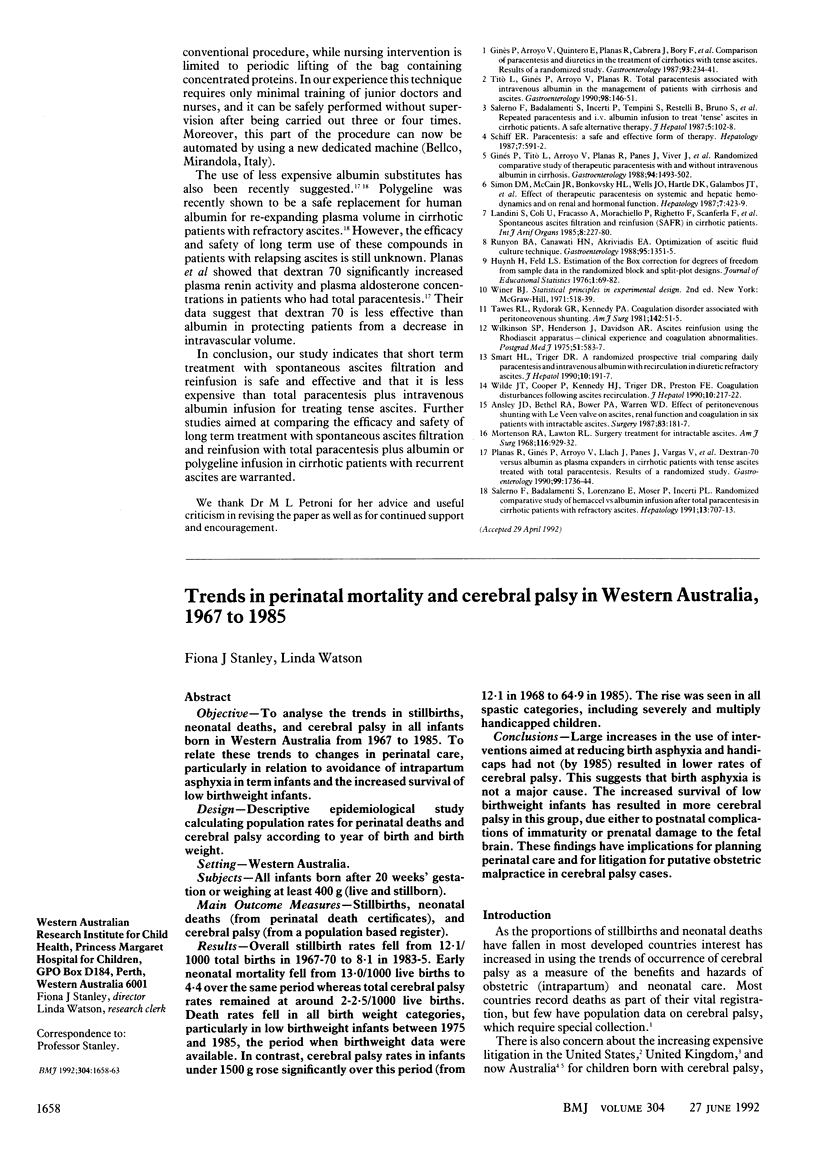
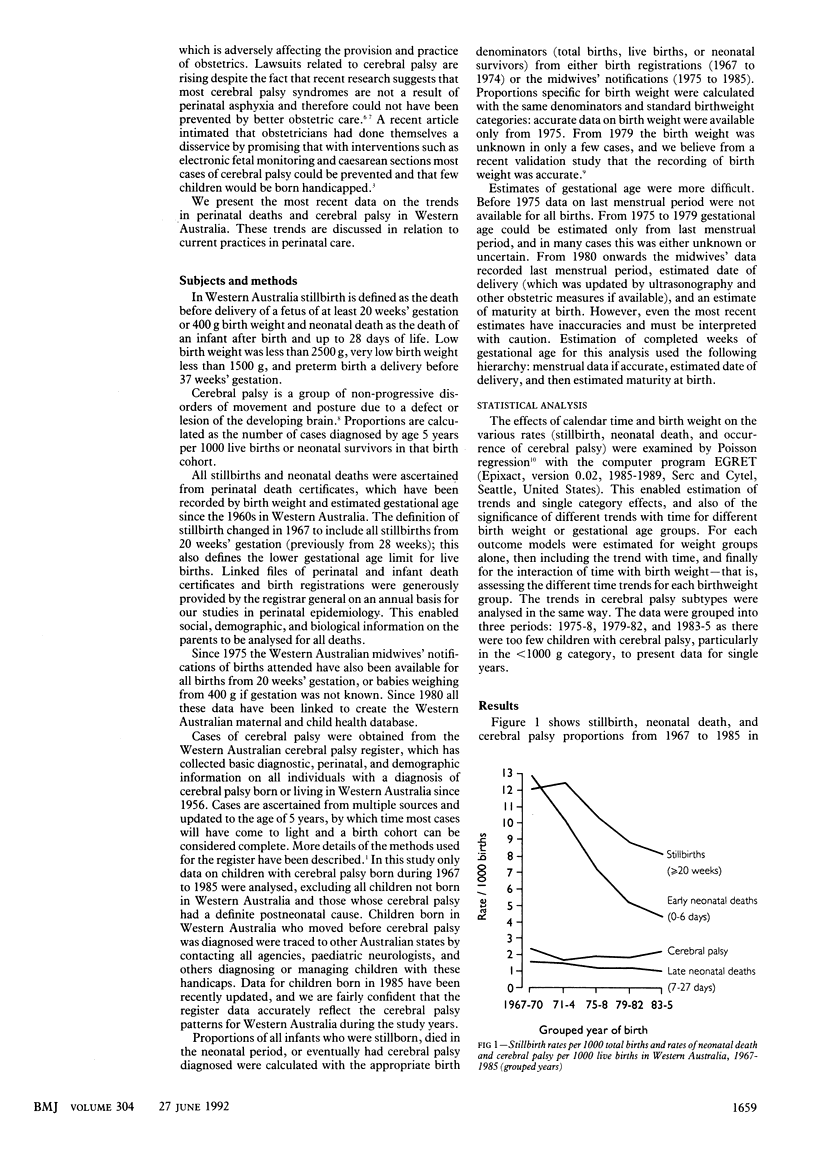
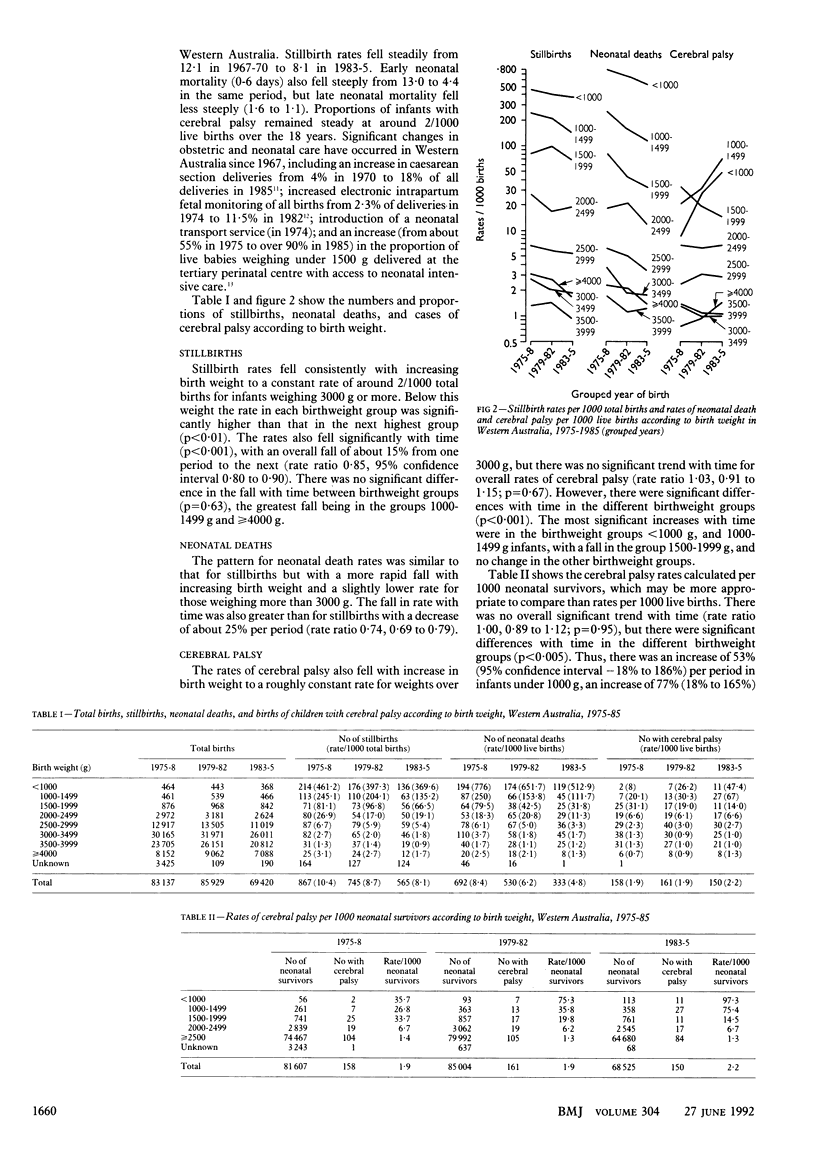
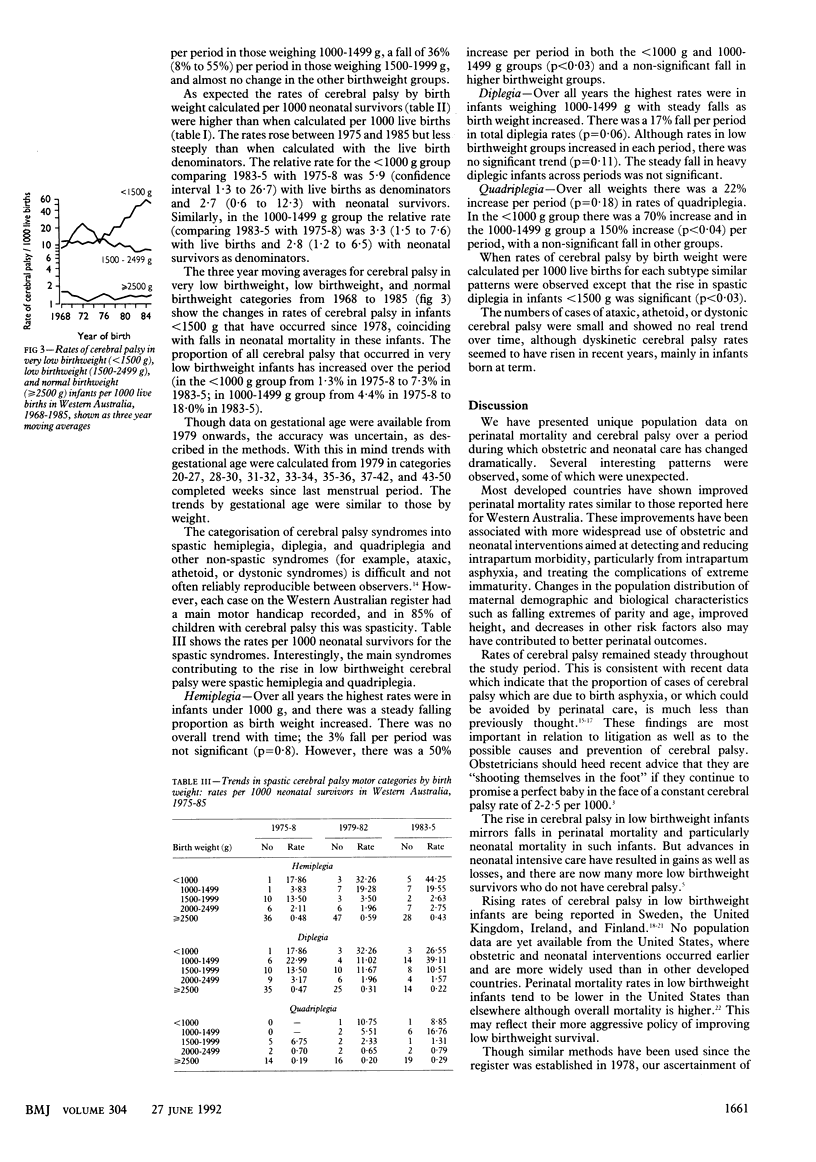
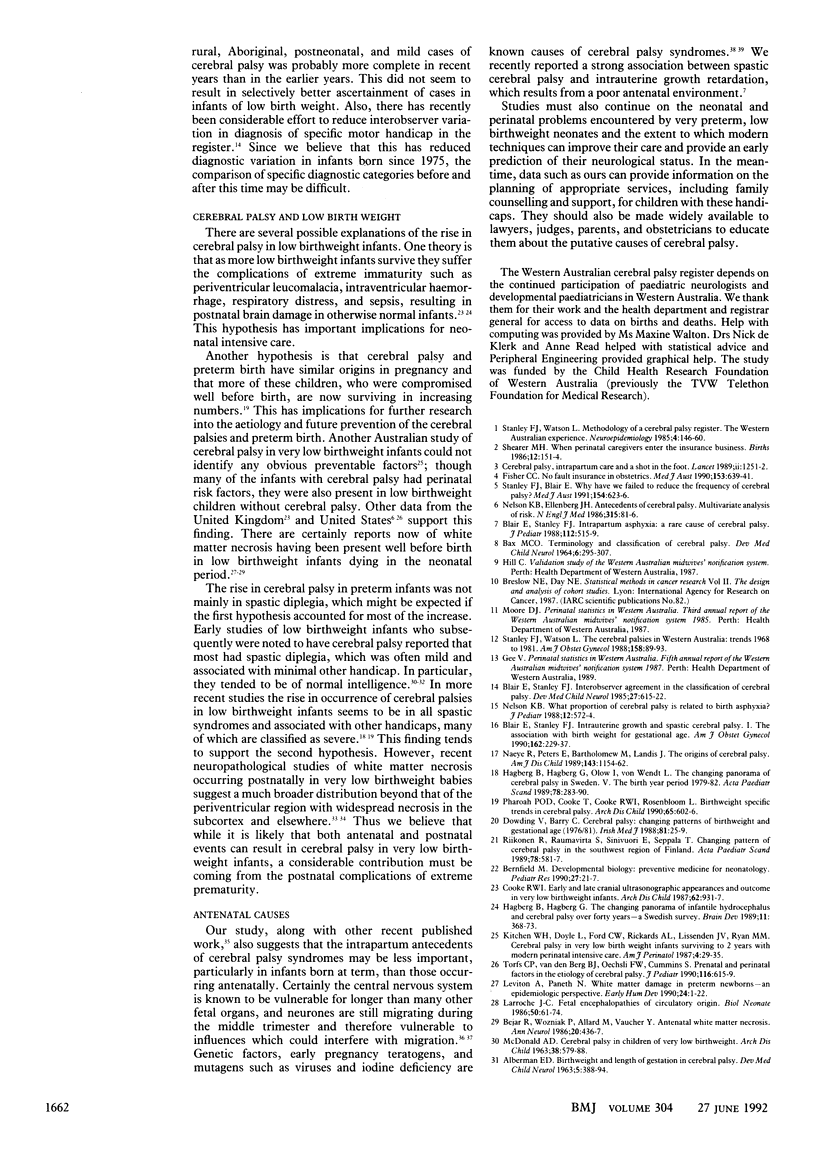
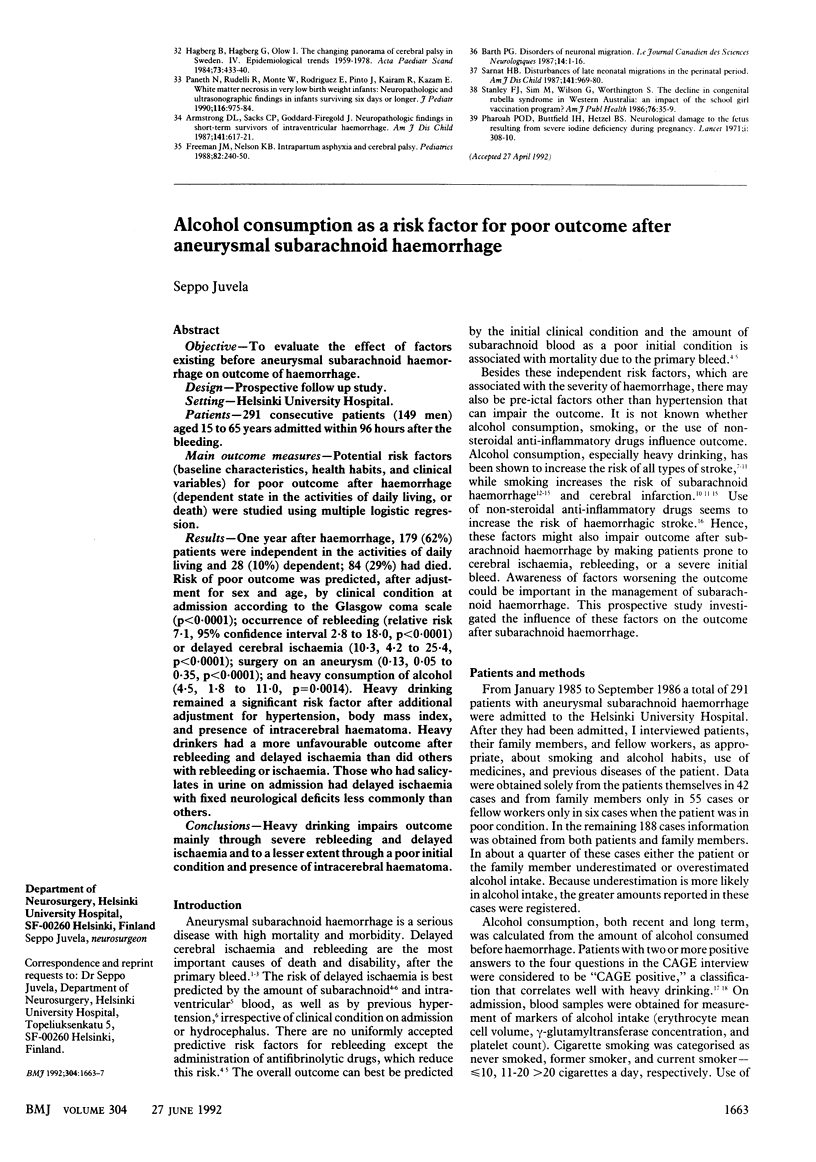
Selected References
These references are in PubMed. This may not be the complete list of references from this article.
- ALBERMAN E. BIRTH WEIGHT AND LENGTH OF GESTATION IN CEREBRAL PALSY. Dev Med Child Neurol. 1963 Aug;5:388–394. doi: 10.1111/j.1469-8749.1963.tb05043.x. [DOI] [PubMed] [Google Scholar]
- Armstrong D. L., Sauls C. D., Goddard-Finegold J. Neuropathologic findings in short-term survivors of intraventricular hemorrhage. Am J Dis Child. 1987 Jun;141(6):617–621. doi: 10.1001/archpedi.1987.04460060035027. [DOI] [PubMed] [Google Scholar]
- BAX M. C. TERMINOLOGY AND CLASSIFICATION OF CEREBRAL PALSY. Dev Med Child Neurol. 1964 Jun;6:295–297. doi: 10.1111/j.1469-8749.1964.tb10791.x. [DOI] [PubMed] [Google Scholar]
- Barth P. G. Disorders of neuronal migration. Can J Neurol Sci. 1987 Feb;14(1):1–16. doi: 10.1017/s031716710002610x. [DOI] [PubMed] [Google Scholar]
- Blair E., Stanley F. J. Intrapartum asphyxia: a rare cause of cerebral palsy. J Pediatr. 1988 Apr;112(4):515–519. doi: 10.1016/s0022-3476(88)80161-6. [DOI] [PubMed] [Google Scholar]
- Blair E., Stanley F. Interobserver agreement in the classification of cerebral palsy. Dev Med Child Neurol. 1985 Oct;27(5):615–622. doi: 10.1111/j.1469-8749.1985.tb14133.x. [DOI] [PubMed] [Google Scholar]
- Blair E., Stanley F. Intrauterine growth and spastic cerebral palsy. I. Association with birth weight for gestational age. Am J Obstet Gynecol. 1990 Jan;162(1):229–237. doi: 10.1016/0002-9378(90)90856-3. [DOI] [PubMed] [Google Scholar]
- Cooke R. W. Early and late cranial ultrasonographic appearances and outcome in very low birthweight infants. Arch Dis Child. 1987 Sep;62(9):931–937. doi: 10.1136/adc.62.9.931. [DOI] [PMC free article] [PubMed] [Google Scholar]
- Dowding V. M., Barry C. Cerebral palsy: changing patterns of birthweight and gestational age (1976/81). Ir Med J. 1988 Nov;81(1):25–29. [PubMed] [Google Scholar]
- Fisher C. C. No-fault insurance in obstetrics. Med J Aust. 1990 Dec 3;153(11-12):639–641. doi: 10.5694/j.1326-5377.1990.tb126307.x. [DOI] [PubMed] [Google Scholar]
- Freeman J. M., Nelson K. B. Intrapartum asphyxia and cerebral palsy. Pediatrics. 1988 Aug;82(2):240–249. [PubMed] [Google Scholar]
- Hagberg B., Hagberg G., Olow I. The changing panorama of cerebral palsy in Sweden. IV. Epidemiological trends 1959-78. Acta Paediatr Scand. 1984 Jul;73(4):433–440. doi: 10.1111/j.1651-2227.1984.tb09951.x. [DOI] [PubMed] [Google Scholar]
- Hagberg B., Hagberg G., Olow I., von Wendt L. The changing panorama of cerebral palsy in Sweden. V. The birth year period 1979-82. Acta Paediatr Scand. 1989 Mar;78(2):283–290. doi: 10.1111/j.1651-2227.1989.tb11071.x. [DOI] [PubMed] [Google Scholar]
- Hagberg B., Hagberg G. The changing panorama of infantile hydrocephalus and cerebral palsy over forty years--a Swedish survey. Brain Dev. 1989;11(6):368–373. doi: 10.1016/s0387-7604(89)80018-x. [DOI] [PubMed] [Google Scholar]
- Kitchen W. H., Doyle L. W., Ford G. W., Rickards A. L., Lissenden J. V., Ryan M. M. Cerebral palsy in very low birthweight infants surviving to 2 years with modern perinatal intensive care. Am J Perinatol. 1987 Jan;4(1):29–35. doi: 10.1055/s-2007-999733. [DOI] [PubMed] [Google Scholar]
- Larroche J. C. Fetal encephalopathies of circulatory origin. Biol Neonate. 1986;50(2):61–74. doi: 10.1159/000242570. [DOI] [PubMed] [Google Scholar]
- Leviton A., Paneth N. White matter damage in preterm newborns--an epidemiologic perspective. Early Hum Dev. 1990 Oct;24(1):1–22. doi: 10.1016/0378-3782(90)90002-z. [DOI] [PubMed] [Google Scholar]
- MCDONALD A. D. CEREBRAL PALSY IN CHILDREN OF VERY LOW BIRTH WEIGHT. Arch Dis Child. 1963 Dec;38:579–588. doi: 10.1136/adc.38.202.579. [DOI] [PMC free article] [PubMed] [Google Scholar]
- Naeye R. L., Peters E. C., Bartholomew M., Landis J. R. Origins of cerebral palsy. Am J Dis Child. 1989 Oct;143(10):1154–1161. doi: 10.1001/archpedi.1989.02150220044018. [DOI] [PubMed] [Google Scholar]
- Nelson K. B., Ellenberg J. H. Antecedents of cerebral palsy. Multivariate analysis of risk. N Engl J Med. 1986 Jul 10;315(2):81–86. doi: 10.1056/NEJM198607103150202. [DOI] [PubMed] [Google Scholar]
- Nelson K. B. What proportion of cerebral palsy is related to birth asphyxia? J Pediatr. 1988 Apr;112(4):572–574. doi: 10.1016/s0022-3476(88)80169-0. [DOI] [PubMed] [Google Scholar]
- Paneth N., Rudelli R., Monte W., Rodriguez E., Pinto J., Kairam R., Kazam E. White matter necrosis in very low birth weight infants: neuropathologic and ultrasonographic findings in infants surviving six days or longer. J Pediatr. 1990 Jun;116(6):975–984. doi: 10.1016/s0022-3476(05)80664-x. [DOI] [PubMed] [Google Scholar]
- Pharoah P. O., Buttfield I. H., Hetzel B. S. Neurological damage to the fetus resulting from severe iodine deficiency during pregnancy. Lancet. 1971 Feb 13;1(7694):308–310. doi: 10.1016/s0140-6736(71)91040-3. [DOI] [PubMed] [Google Scholar]
- Pharoah P. O., Cooke T., Cooke R. W., Rosenbloom L. Birthweight specific trends in cerebral palsy. Arch Dis Child. 1990 Jun;65(6):602–606. doi: 10.1136/adc.65.6.602. [DOI] [PMC free article] [PubMed] [Google Scholar]
- Riikonen R., Raumavirta S., Sinivuori E., Seppälä T. Changing pattern of cerebral palsy in the southwest region of Finland. Acta Paediatr Scand. 1989 Jul;78(4):581–587. doi: 10.1111/j.1651-2227.1989.tb17940.x. [DOI] [PubMed] [Google Scholar]
- Sarnat H. B. Disturbances of late neuronal migrations in the perinatal period. Am J Dis Child. 1987 Sep;141(9):969–980. doi: 10.1001/archpedi.1987.04460090046022. [DOI] [PubMed] [Google Scholar]
- Shearer M. H. When perinatal caregivers enter the insurance business. Birth. 1986 Sep;13(3):151–152. doi: 10.1111/j.1523-536x.1986.tb01036.x. [DOI] [PubMed] [Google Scholar]
- Stanley F. J., Blair E. Why have we failed to reduce the frequency of cerebral palsy? Med J Aust. 1991 May 6;154(9):623–626. doi: 10.5694/j.1326-5377.1991.tb121226.x. [DOI] [PubMed] [Google Scholar]
- Stanley F. J., Sim M., Wilson G., Worthington S. The decline in congenital rubella syndrome in Western Australia: an impact of the school girl vaccination program? Am J Public Health. 1986 Jan;76(1):35–37. doi: 10.2105/ajph.76.1.35. [DOI] [PMC free article] [PubMed] [Google Scholar]
- Stanley F. J., Watson L. Methodology of a cerebral palsy register. The Western Australian experience. Neuroepidemiology. 1985;4(3):146–160. doi: 10.1159/000110226. [DOI] [PubMed] [Google Scholar]
- Stanley F. J., Watson L. The cerebral palsies in Western Australia: trends, 1968 to 1981. Am J Obstet Gynecol. 1988 Jan;158(1):89–93. doi: 10.1016/0002-9378(88)90784-3. [DOI] [PubMed] [Google Scholar]
- Torfs C. P., van den Berg B., Oechsli F. W., Cummins S. Prenatal and perinatal factors in the etiology of cerebral palsy. J Pediatr. 1990 Apr;116(4):615–619. doi: 10.1016/s0022-3476(05)81615-4. [DOI] [PubMed] [Google Scholar]


